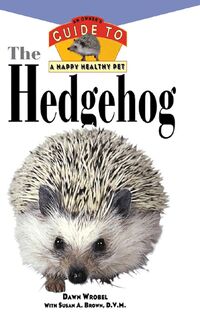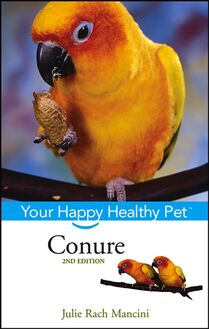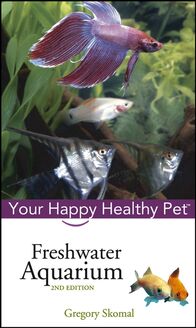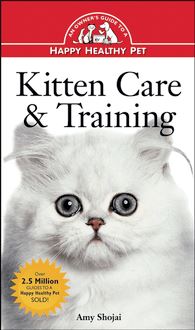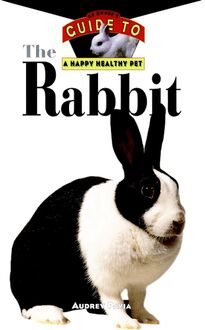-
 Univers
Univers
-
 Ebooks
Ebooks
-
 Livres audio
Livres audio
-
 Presse
Presse
-
 Podcasts
Podcasts
-
 BD
BD
-
 Documents
Documents
-
- Cours
- Révisions
- Ressources pédagogiques
- Sciences de l’éducation
- Manuels scolaires
- Langues
- Travaux de classe
- Annales de BEP
- Etudes supérieures
- Maternelle et primaire
- Fiches de lecture
- Orientation scolaire
- Méthodologie
- Corrigés de devoir
- Annales d’examens et concours
- Annales du bac
- Annales du brevet
- Rapports de stage
La lecture à portée de main
Vous pourrez modifier la taille du texte de cet ouvrage
Découvre YouScribe en t'inscrivant gratuitement
Je m'inscrisDécouvre YouScribe en t'inscrivant gratuitement
Je m'inscrisEn savoir plus
Vous pourrez modifier la taille du texte de cet ouvrage
En savoir plus

Description
An Owner's Guide to a Happy Healthy Pet is the series to turn to when you want a basic reference that's reliable, up-to-date, and complete. These guides feature:
* Expert authors, plus renowned guest contributors on specialized topics
* Full-color photos throughout
* Basic information on the breed, species, or topic
* Complete coverage of care, health, grooming, training, and more
* Tips and techniques to make life with a pet more rewarding
PART ONE: Welcome to the World of the Parrot.
1. About Parrots.
2. Selecting the Right Parrot.
PART TWO: Parrot Profiles.
3. Parrot Profiles.
PART THREE: Living with Your Parrot.
4. Your Parrot's Home.
5. Feeding Your Parrot.
6. Your Parrot's Physical Health.
7. Your Parrot's Mental Health.
PART FOUR: Beyond the Basics.
8. Recommended Reading.
9. Resources.
Sujets
Informations
| Publié par | Turner Publishing Company |
| Date de parution | 20 août 2007 |
| Nombre de lectures | 0 |
| EAN13 | 9780470252680 |
| Langue | English |
| Poids de l'ouvrage | 1 Mo |
Informations légales : prix de location à la page 0,0750€. Cette information est donnée uniquement à titre indicatif conformément à la législation en vigueur.
Extrait
The
Parrot
Howell Book House
Howell Book House
A Simon Schuster Macmillan Company
1633 Broadway
New York, NY 10019
Copyright 1996 by Howell Book House
All rights reserved. No part of this book may be reproduced or transmitted in any form or by any means, electronic or mechanical, including photocopying, recording, or by any information storage and retrieval system, without permission in writing from the Publisher.
MACMILLAN is a registered trademark of Macmillan, Inc.
Library of Congress Cataloging-in-Publication Data
Freud, Arthur.
The parrot : an owner s guide to a happy, healthy pet / Arthur Freud.
p. cm.
ISBN 0-87605-497-1 (alk. paper)
1. Parrots. I. Title.
SF473.P3F736 1996 96-9031
636.6 865-dc20 CIP
Manufactured in the United States of America
10 9 8 7 6 5 4 3 2 1
Series Director: Dominique DeVito
Series Assistant Director: Ariel Cannon
Book Design: Michele Laseau
Cover Design: Iris Jeromnimon
Illustration: Ryan Oldfather
Photography:
Front and back cover photos by Ron and Val Moat, inset: Pets by Paulette
Joan Balzarini: 9, 13, 17, 18, 20, 21, 28, 35, 37, 40, 47, 48, 50, 52, 53, 57, 58, 63, 64, 68, 69, 70, 71, 73, 76, 78, 79, 80, 81, 84, 85, 87, 97, 103, 104, 108, 111, 117
Joan Blankenship: 7
Paulette Braun/Pets by Paulette: 12, 14, 16, 19, 26, 38, 43, 44, 45, 46, 50, 60, 69, 72, 74, 96, 98, 110, 112, 112, 116, 119
Diane Clakins: 77
Michael DeFraitas: 39, 49, 55, 60, 66-67
Arthur Freud: 10, 39, 61, 89, 101
Scott McKiernan/Zuma Press: 2-3, 5, 6, 41, 54, 74
Ron and Val Moat: 30-31, 45, 56
A.J. Mobbs: 88
Positively Pets: 27
Robert Pearcy: 25, 59, 62
Pablo Tiengo: 36, 42, 51
B. Everett Webb: 65, 115
A. Wilson: 39
Jean Wentworth: 11, 15, 22, 120-121
Production Team: John Carroll, Kathleen Caulfield, Vic Peterson, Terri Sheehan, and Chris Van Camp
Contents
part one
Welcome to the World of the Parrot
1 About Parrots
2 Selecting the Right Parrot
part two
Parrot Profiles
3 Parrot Profiles
part three
Living with Your Parrot
4 Your Parrot s Home
5 Feeding Your Parrot
6 Your Parrot s Physical Health
7 Your Parrot s Mental Health
part four
Beyond the Basics
8 Recommended Reading
9 Resources
part one
chapter 1
About
Parrots
The parrot family consists of more than 350 different species of birds. They include groups such as Amazons, African Greys, macaws, cockatoos, eclectus, conures, lories and lovebirds. Although most people do not realize it, technically even budgies and cockatiels are classified in the parrot family. Though they are small, they too possess the basic traits all parrots share, including a large, broad head, a short neck and a heavy, powerful beak with the upper beak overhanging the lower. Parrots feet all have four toes, with two pointing forward and two backward.
Parrots are wild animals. Though they may be domestically bred and hand-fed, they have lived with human beings for two generations at most. How did parrots come to be one of the most popular pet birds, with over 1.2 million parrots in households around the United States?
The parrot family includes over 350 different species of birds, including the African Grey (on the left) and the Yellow-naped Amazon.
Parrots ancestors developed 35 million years ago, the descendants of reptiles whose scales mutated into useful flying technology. Flying gave these new creatures a whole new niche to populate and thrive in; they had advantages in both finding food and fleeing predators and the new creatures flourished and continued to evolve and adapt. Parrot fossils millions of years old have been found in England, France, Australia, Africa and South America.
History of Parrot Keeping
Parrots have adapted to life in jungle environment over millions of years. However, human beings have long had a fascination with these beautiful creatures and have kept them as pets for centuries.
P ARROTS I N C LASSICAL C IVILIZATION
According to some sources, parrots were introduced to Greco-Roman civilization after Alexander the Great returned from his Indian expedition. These first imported parrots were probably Ringnecks from India or related islands. In Greek and Roman culture, these exotic birds were housed in beautiful cages of precious materials, and were worth a great deal of money.
P ARROTS I N E UROPE
After Vasco de Gama found a sea route to Europe, parrot importation increased. The birds no longer had to be funneled through third parties in Arab countries. This elimination of the third party made parrot prices slightly more reasonable, and these birds became more widely available and popular. Keep in mind, however, that parrot availability was still limited to the highest echelons of society. Keeping an ornamental animal that did no useful work around the farm or home was entirely out of reach for the average citizen.
In the last twenty years, parrots have become one of the most popular pet birds in America. (Yellow-fronted Amazon)
Typically, many members of European royal families had parrots. Henry VIII had an African Grey with manners allegedly as bad as his own. And Columbus purportedly brought back a pair of Cuban Amazons to Queen Isabella when he returned from his first expedition to the Americas.
Global exploration increased during the eighteenth century and flourished especially during the nineteenth century. Ventures to the New World to learn about the creatures, geography and exploitable resources of the continent were common. Knowledge about parrots increased with every venture intended to understand, observe or even capture them. Victorians made great strides and showed great interest in understanding the physical and behavioral mechanisms of these new creatures. Though their methods may be considered unethical by today s standards, their research and understanding contributed immeasurably to many sciences, including the modern study of biology, natural history and the environment.
In addition to studying parrots at great length, the Victorians were also the first to truly popularize these birds. The Victorian sensibility was intrigued by these exotic creatures who mimicked the sounds of human voices. A parlor in a well-done home was incomplete without a parrot. Parrot popularity reached an all-time high during the end of the last century.
PARROT TRAITS
Though parrots vary greatly in almost every respect, the characteristics found in all parrot species serve to classify them together. These traits include: Large head Short neck Four toes, three pointing forward one backward Large beak, with upper overhanging lower
In the 1920s, however, several outbreaks of parrot-related diseases frightened prospective owners and the public at large. In the United States, a ban on parrot importation was enacted in 1946, though lifted in 1967. Throughout the next decades, outbreaks of parrot-related diseases, often caused by inadequate quarantine periods, caused the government to implement several restrictions on parrot importation. However, new quarantine procedures and an immense increase in the numbers of birds who are bred in captivity has allowed parrots to once again be kept without fear of contagious disease.
The Parrot in the United States
P ARROT I MPORTATION
The popularity of these birds in this country has fluctuated with changes in prices, lifestyles and availability. Before the 1970s, parrots were imported, then banned when outbreaks of parrot-related diseases arose. These bans didn t stop illegal imports from entering the country, but in 1973 quarantine stations were established in the United States, allowing birds to be safely imported. A period of vast importation of parrots followed, lasting almost twenty years. By the end of this period many countries had imposed restrictions on exporting their exotic wildlife. In 1992, the Wild Bird Conservation Act became law in the United States and effectively ended all importation of parrots.
The domestically bred parrots available today are healthier than their imported ancestors and have bonded with humans since birth.
There was only a limited amount of domestic breeding of parrots until the mid 1980s. Most of the parrots purchased during the 1970s and early 1980s were imports and required a quarantine period and a considerable amount of taming and training when they were finally brought home. These birds were not always easy to work with as they had experienced a certain degree of trauma in being captured, exported and then moved from quarantine to distributor to pet shop to final owner. In addition, the thirty-day quarantine period involved medication with heavy doses of chlortetracycline. This regimen prevented the release of any parrots carrying an infectious disease. Unfortunately, thirty days of such strong medication can have a negative effect on a parrot s spleen and liver.
Today, domestically bred offspring of imported parrots, like these two baby African Greys, are available.
P ARROT C ONSERVATION
For many reasons, including habitat destruction and excessive capture of parrots for the wildlife trade, many populations of parrots are now threatened in their native habitats. Many measures have been enacted to stop the endangerment of these beautiful birds. The continued importation of parrots into the United States has been effectively halted by the Wild Bird Importation Act of 1992. International treaties, namely the Convention on International Trade in Endangered Species of Flora and Fauna (CITES), also limit the importation of wildlife. In many cases, captive breeding may be the only way to keep up population levels, and there are many species of endangered parrots which you should never consider keeping if you do not plan to breed them. Become involved in the parrot conservation effort by learning about these magnificent birds in their natural homes and in captivity. Educate yourself on the conditions of their habitats and species preservation, and help make others aware of these
-
 Univers
Univers
-
 Ebooks
Ebooks
-
 Livres audio
Livres audio
-
 Presse
Presse
-
 Podcasts
Podcasts
-
 BD
BD
-
 Documents
Documents
-
Jeunesse
-
Littérature
-
Ressources professionnelles
-
Santé et bien-être
-
Savoirs
-
Education
-
Loisirs et hobbies
-
Art, musique et cinéma
-
Actualité et débat de société
-
Jeunesse
-
Littérature
-
Ressources professionnelles
-
Santé et bien-être
-
Savoirs
-
Education
-
Loisirs et hobbies
-
Art, musique et cinéma
-
Actualité et débat de société
-
Actualités
-
Lifestyle
-
Presse jeunesse
-
Presse professionnelle
-
Pratique
-
Presse sportive
-
Presse internationale
-
Culture & Médias
-
Action et Aventures
-
Science-fiction et Fantasy
-
Société
-
Jeunesse
-
Littérature
-
Ressources professionnelles
-
Santé et bien-être
-
Savoirs
-
Education
-
Loisirs et hobbies
-
Art, musique et cinéma
-
Actualité et débat de société
- Cours
- Révisions
- Ressources pédagogiques
- Sciences de l’éducation
- Manuels scolaires
- Langues
- Travaux de classe
- Annales de BEP
- Etudes supérieures
- Maternelle et primaire
- Fiches de lecture
- Orientation scolaire
- Méthodologie
- Corrigés de devoir
- Annales d’examens et concours
- Annales du bac
- Annales du brevet
- Rapports de stage


